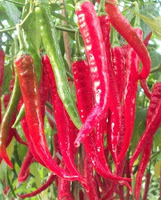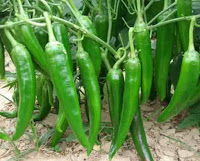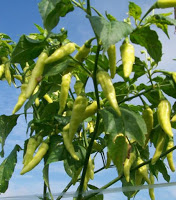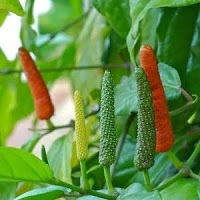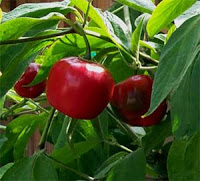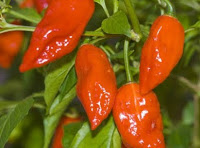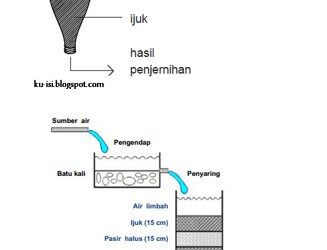SCIENTIFIC PAPERS
Benefits, Types, and Guidelines for Cultivating Chili Plants
By :
| Name | : Siti Khotijah |
| NIS/NISN | : 170737/0026997876 |
| Study program | : Natural Sciences |
AL AHROM ISLAMIC EDUCATION FOUNDATION
MADRASAH ALIYAH AL AHROM KARANGSARI
TERAKREDITASI – B
Jl. Nangka No.45 Kelurahan Karangsari, Kecamatan Karangtengah, Kabupaten Demak
Telp. (0291) 690355 Email [email protected] Website https://mas-alahrom.my.id/
TAHUN PELAJARAN 2019/2020
CHAPTER I
INTRODUCTION
- Background of Scientific Papers
Chili is the main ingredient in cooking. This chili has a lot of demand, and the price is also very valued. So that when this chili business is doing, it will get huge benefits because planting the right chili will produce satisfying chili.
Chili is one of the spice commodities that is widely cultivated by farmers in Indonesia because it has a high selling price and has several health benefits. One of them is the capsaicin substance are functions in prevent cancer. Besides, the high enough vitamin C content in chilies can meet everyone’s daily needs, but it must be consumed in moderation to avoid stomach pain. Except for cooking, spice chilies are also used as a mixture of the food industry and for animal husbandry.
Cayenne pepper aka small chili presumed to be the original chili of Tropical America (South). Compared to its large chili peers, chilies are classified as tolerant because they want to plant in the lowlands and highlands which reach an altitude of about 1,000 meters to more than 1,500 meters above sea level. Also, it can still be planting in areas with high rainfall. Then the age of the tree, if taken seriously, can reach 3-4 years with the product still high.
The chili farming business is still very profitable for the people of Indonesia. The needs of the Indonesian people for chili have a record in the range of 3kg/capita/year. If the total population of Indonesia is 250 million, it means that 750,000 tonnes per year are needed (2010). In 2009 chili production in Indonesia reached 7.04 tonnes/ha, while in 2010 chili production in Indonesia reached 3.83 tonnes/ha. One of the obstacles to the decline in chili production is the presence of disease disorders that can strike from the time the plants are sown to the harvested plants. Disease disorders in chili plants are very complex, both in the rainy season and the dry season. It can even cause substantial losses.
- Solution of Problem
- What are the health benefits of cayenne pepper?
- What are the different kinds of chilies?
- The technique of growing cayenne pepper?
- What are the advantages and disadvantages of cayenne pepper?
- Writing Purpose
- To find out information to readers about chili plants,
- Made readers know the origin of chili cultivation,
- Increase readers’ knowledge about cayenne pepper cultivation.
- Benefits of Research
- Provide information about cayenne pepper;
- As an insight to know several types of chili;
- Understand about growing chilies.
- Benefits of Readers
- Give information about cayenne pepper,
- Knowing all the benefits of cayenne pepper,
- Understand the use of chilies.
Read Also :
- Efforts to Cleaning Dirty Water Into Ready-to-Consume Water In a Simple Way
- Use of EggShells as A Craft Material for Friendly Environment
- Traditional Medicine and Benefits from Spices
BAB II
STUDY
- Theoretical Foundations
Chili is a leading horticultural plant and is widely cultivated, especially on the island of Java. Chili is an annual plant in the form of shrubs, stands upright with woody stems, and has many branches. Mature plant height is between 65-120 cm, crown width 50-90 cm (Setiadi, 2006)
There are 3 kinds of chilies according to size, the big ones, the small ones like cayenne pepper, and slightly oval chilies these are less spicy, red, and green, but consumers in Indonesia usually like it when it’s still green, for vegetables, or eating raw as a salad. Likewise, the large, long chilies picked after they turn red, as a vegetable mixer or dried as flour (Kartasapoetra, 1988).
Chili plants originate from the American continent, Latin America. Besides that, the chili plant originated from Peru. Some say that the ancient Mexicans loved chilies since 7000 past before Columbus discovered the American continent (1492). Christophorus Colombus then spread and popularized chilies from the American continent to Spain in 1492. In the early 1500s, the Portuguese began trading chilies to Macao and Goa, then entered India, China, and Thailand. Around 1513 the Ottoman Empire occupied the Portuguese territory of Hormuz, Persian Gulf. This is where the Turks get to know chili. When Turkey occupied Hungary, chili was popular in Hungary.
Cayenne pepper is common cultivated in various countries, the result is in addition to being self-sufficient because it is much needed in countries with cold weather.
- Descriptions
- Benefits of Cayenne Pepper for Health
- Boost Your Metabolism
Cayenne pepper can speed up your body’s metabolism. Therefore, be happy for those of you who can stand the spicy taste of cayenne pepper. Because it speeds up the body’s metabolism, cayenne pepper is one of the foods that can help you lose weight.
- Helps Prevent Heart Attacks
Cayenne pepper is also useful for your heart, as it can prevent a deadly heart attack in seconds. This because of the characteristic of cayenne pepper which can open arteries in the heart.
- Helps Hair Growth
Cayenne pepper can also help your hair grow. One of the main reasons for baldness is due to decreased blood circulation (blood stagnation). When applied to the scalp, cayenne pepper improves blood circulation, thereby promoting hair growth. Indeed this will irritate the scalp, but it will provide health benefits.
- Helps Relieve Pain Naturally
Cayenne pepper can help relieve pain. Many people suffer from headaches, and consuming cayenne pepper will provide benefits to reduce migraine headaches. Eating chilies will also help people suffering from sinus symptoms. Cayenne pepper can also help to help out toothaches and pain of gums.
- Help You Lose Weight
Cayenne pepper also can aid in weight loss. This because the spicy capsaicin in cayenne pepper will be burning your fat and sweat it out. Besides, it is also due to cayenne pepper helps increase the body’s metabolism, which can also reduce weight faster. Eating cayenne pepper will also reduce your appetite, so it is suitable if you want to limit eating while on a diet.
- Helps A Sore Throat
Cayenne pepper can also help relieve sore throats. Mix the bird’s eye chilies with water and gargle. This procedure will help quickly relieve a sore throat.
- Prevent High Blood Pressure
Cayenne pepper can help improve blood circulation, by reducing blood formation and clotting. Therefore, cayenne pepper is a natural remedy that can help reduce and prevent high blood pressure.
- Helps Cure Infection
Cayenne pepper also helps cure various infections due to its anti-fungal properties.
- Helps Cure Entrails Pain
Cayenne pepper can also help heal intestinal wounds, which are caused by peristalsis during the digestive process. So that chilies will provide benefits to digestive health, and help heal various intestinal problems.
- Prevent Cancer
The most important benefit of consuming cayenne pepper is that it helps reduce the risk of cancer, and can inhibit the development of lung cancer cells and pancreatic cancer. The cayenne pepper compound that can do this is none other than capsaicin which gives a spicy taste. This process is known as apoptosis.
- Types of Chili
- Big Red Chili
These chilies are 10 to 15 cm long and 2-3 cm in diameter. Thick skin and not too spicy. When it is ripe it has a bright red color. It is long and large, long, and large. The surface of the writing is smooth, shiny, and thick as if there is wax on the skin.
- Curly Red Chili
The shape is long but has a small diameter compared to large chilies, the tip tends to be sharp. The fruit skin is not smooth but wavy or curly. The rind is relatively thin.
- Green Chili
Green chilies are large red chilies but are harvested when the chilies are still green. Harvesting is still young and not yet at its full maturity.
- Cayenne pepper
Cayenne pepper is small and about 2-4 cm long. These chilies are almost entirely spicier than the large chilies, but not all cayenne peppers are all spicy. Cayenne pepper is unique with a variety of colors, ranging from green, red, yellow to orange.
- Javanese Chili
This type of chili is not from the Capsicum Annuum family but belongs to the Betel Family or Piperaceae Family. Even so, Javanese chilies also have a spicy taste, or Javanese chilies are sometimes called herbal chilies.
- Cherry Chili Pepper
2-3 cm in length, the color red, irregular shape, at first glance, it looks like a cherry.
- Rocoto Chili Peppers
This chili is found in Peru, Bolivia, Chile, Northern Argentina, and Ecuador. It is almost round in shape and has thick flesh like peppers. These chilies will be very spicy when the seeds are black.
- Gendol Chili
This type of cayenne pepper is called gendot or gendol, which has a fatter and bigger shape. It is also spicier than other types of cayenne pepper. The color varies greatly from green, yellow, orange, to bright red.
- Hot Chili Peppers
Hot chili peppers or many people called devil chili peppers are the hottest chilies in the world. This chili comes from northeast India (Assam, Nagaland, and Manipur) and Bangladesh. The level of spiciness of this chili reaches 1,001,304 on the Scoville scale and it means that the level of spiciness of this chili exceeds cayenne pepper.
- The technique of growing cayenne pepper
- Chili Seeds
How to grow chilies, of course, starts with seeds. First of all, of course, you must have quality chili seeds. It’s quite easy to choose chili seeds. Choose chili seeds that are still fresh. Peel the chilies then take the seeds. After that, dry it in the sun to dry. Another way to get chili seeds is to buy chili seeds at the store. However, if you want to grow chilies on a small scale, it’s better to make the seeds yourself. Chili seeds that are sold in stores are usually large in scale and of course expensive.
- Sowing Chili
The next step is to sow the chilies. Use a small polybag as a seeding medium. Enter the soil and also fertilizer. Mix until the polybag height. Put the chili seeds in a polybag and water them every day. For more details, here’s how to sow chili seeds so they grow fast:
-
- Prepare a nursery. Polybag for example.
- Enter the soil and manure in a ratio of 3: 1.
- Leave it in a place protected from rain and sunshine for 1 week.
- Soak the seeds in warm water for 3 hours.
- Then place the seeds in the polybag. Cover the seeds with soil about 1 cm deep.
- Wait for the seeds to germinate.
- Then began to be introduced to direct sunlight.
- Chili Growing
After 4 weeks of age, transfer the chili seeds to the prepared land. Don’t forget to loosen the soil and apply fertilizer. Be careful when removing the seeds from the polybag so that the roots are not damaged. If you still use polybags, use polybags with a diameter of at least 30 cm. You can also use an old bucket that has been cleaned. Use a 3: 2: 1 ratio with the breakdown of soil, fertilizer, and raw husks for planting.
- Fertilizer for Growing Chili Peppers
During the planting period, be diligent about fertilizing. Use compost to make the chilies more organic.
- Chili Treatment
Don’t forget to water the chilies every day. And also often see if other plants grow that will interfere with the growth of chilies. If there is, pull it out regularly so that the chilies can grow properly.
- Harvest Chillies Properly
When the chilies are fully grown. You can do the harvest. Here’s how to harvest chilies that are good and correct:
-
- Picking chilies should be done in the afternoon before the afternoon, or late in the evening (dusk);
- Picking chilies is not pulled upwards, but what is correct is that it is twisted clockwise.
- Picking chilies should prioritize fruit that is old or ripe on the tree, adjust it as needed;
- In some very fruitful chili plants, so that the flowers coincide with other ripe or ripe fruit, then picking can be done by twisting slowly using the right hand, meanwhile with his left hand holding several segments of the stem so that the chili plant stems remain good or not broken.
- Advantages and Disadvantages of Cayenne Pepper
All products certainly have advantages and disadvantages. These two things are inevitable in product and human processing. Weaknesses and strengths are always sided by side and there will never be advantages but no drawbacks. Likewise with this chili also has advantages and disadvantages. The advantages and disadvantages are described as follows:
- Advantages
-
- The advantage is more tolerable because cultivation itself does not require significant costs.
- Maintenance is more organized neatly so that it produces a good product too.
- Cleanliness is guaranteed because once a week we do weeding and cleaning the area around the plant.
- The price is cheaper because it is cultivated and immediately sold when it is just picked.
- Disadvantages
-
- Sometimes the results are uncertain because they only rely on the weather.
- Buyers who sometimes don’t take orders.
- The land is not too wide so that the wishes of the buyers are not fulfilled.
- The results are sometimes not as expected.
- Data Analysis
Several factors cause chili plants to not bear fruit optimally
-
Soil
Soil is one of the factors that affect the fertility of chili plants. Even though the quality chili seeds and the reference for planting chilies are beautiful but the soil is not fertile, the reward is not good, they can become stunted, curly, and slow-growing chili plants.
-
Seeds
The selection of quality chili seeds is very important to support success in chili cultivation. If the chili seeds are not good, then that is also a factor in causing the chili plants not to bear maximum fruit.
-
Fertilizer
Fertilizer is an important nutrient for plants, without being fertilized, plants cannot grow properly. One answer that plants are not given fertilizers is that they are not able to bear maximum fruit. Likewise, with chili plants, not given fertilizer, the chilies will not be good.
-
Water
The role of water is no less important than some of the above, and even without water all living things will die, plants will also die. Even chili plants also need water, if there is no water, it means that the land planted with chilies is arid and there is no water, dry interest, for example, and not watered, then in detail, the chili plants will not bear fruit.
Read Also :
- Efforts to Cleaning Dirty Water Into Ready-to-Consume Water In a Simple Way
- Use of EggShells as A Craft Material for Friendly Environment
- Traditional Medicine and Benefits from Spices
BAB III
CONCLUSION
- Conclusion
In developing and cultivating cayenne pepper, it is not just planting according to existing conditions. Because we have to consider and be able to find out the things that might happen in the process of developing this cayenne pepper cultivation. Both in terms of cost and ability to process cayenne pepper. Because things that were initially underestimated and felt as unimportant were those that would have a big impact going forward. Therefore, my advice for those who want to work in this field must really consider the positives and negatives both in terms of finance and the ability and skills in cultivating this plant. And also don’t forget to review the marketing prospects, meaning when after being harvested, where will the cayenne pepper be supplied. So that there is no useless hoarding which will eventually rot and ultimately the losses we will get.
- Suggestions
Cultivating cayenne pepper must pay attention to the steps correctly and precisely.
REFERENCES
Cahyono, B. 2003. Teknik dan Strategi Budi Daya Sawi Hijau (Pai-Tsai). Yayasan Pustaka Nusantara. Yogyakarta.
Djarwaningsih, T. 1984. Jenis- jenis Cabai di Indonesia, dalam Penelitian Peningkatan Pendayagunaan Sumber Daya Alam, hlm 232-235.
Harpenas, Asep & R. Dermawan. 2010. Budidaya Cabai Unggul. Penebar Swadaya. Jakarta.
Hewindati, Yuni Tri dkk. 2006. Hortikultura. Universitas Terbuka. Jakarta.
Rismunandar. 1983. Bertanam Sayur – sayuran. Terate. Bandung.
Sunaryono, H., dan Rismunandar. 1984. Kunci Bercocok Tanam Sayur-sayuran Penting Di Indonesia. CV. Sinar Baru. Bandung
Tjahjadi, Nur. 1991. Bertanam Cabai. Penerbit Kanisius. Yogyakarta.
Read Also :
- Efforts to Cleaning Dirty Water Into Ready-to-Consume Water In a Simple Way
- Use of EggShells as A Craft Material for Friendly Environment
- Traditional Medicine and Benefits from Spices



